Kane v. Fleischer et al., 248 A.D. 554

(New York Supreme Court, Appellate Division New York State Library, Albany. 130.)
Helen Kane claimed that her motivation for suing was not monetary, but rather that they had stolen her identity. “While imitation is the sincerest form of flattery, this type of imitation is the polar opposite,” she was quoted as adding. “It’s not about the money. Fleischer Studios and Paramount Pictures have stolen my idea, and I will not stand for it! Betty Boop is nothing more than a caricature of me, and not a particularly good one.”

Plaintiff originates and still uses a method of singing songs consisting of the interpolation at frequent intervals of the sounds “Boop-Boop-a-Doop,” or “Boop-Boopa-Doop” or “Boop-Boop-Pa-Do” or “Boopa-Doop” or simply “Boop” alone.
Kane was found to be unoriginal after she was unable to establish her allegations in court. “Edward J. McGoldrick” of the Supreme Court ruled: “The plaintiff has failed to sustain either cause of action by proof of sufficient probative force.” Kane, in his opinion, did not invent the scat and baby singing techniques.
It was proven in court that many singers used this style even before the Kane era, and that Kane’s look was common. Footage of child star Baby Esther, and all of the other evidence helped prove that Kane was was not the sole originator.





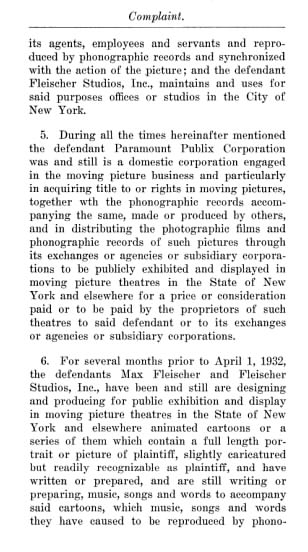







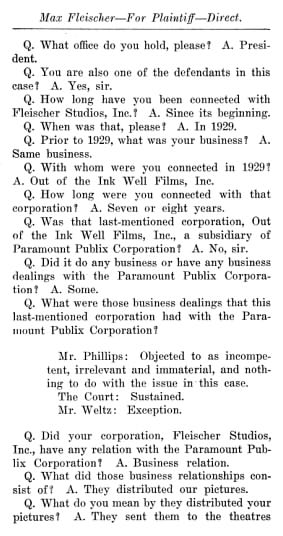


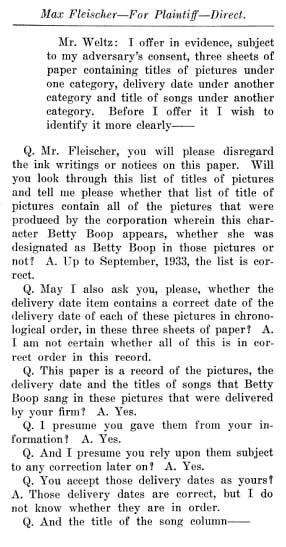




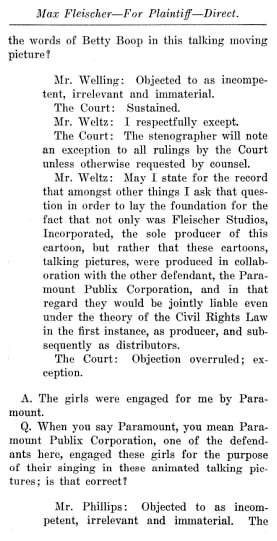

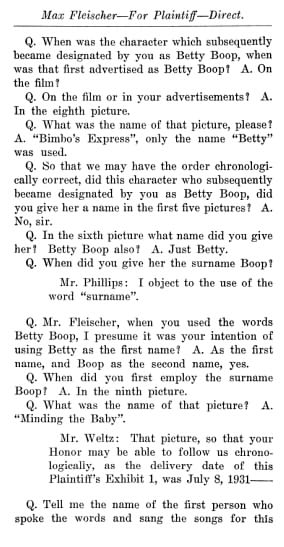





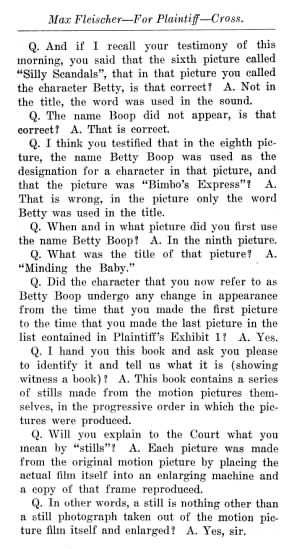
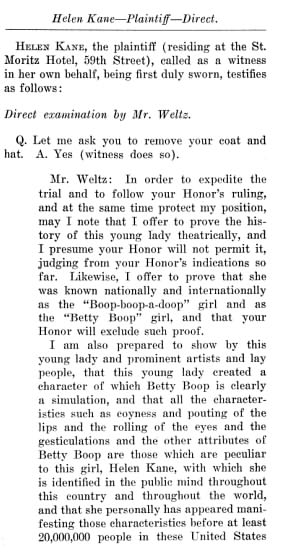




















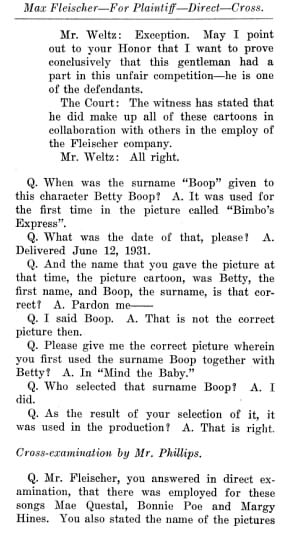
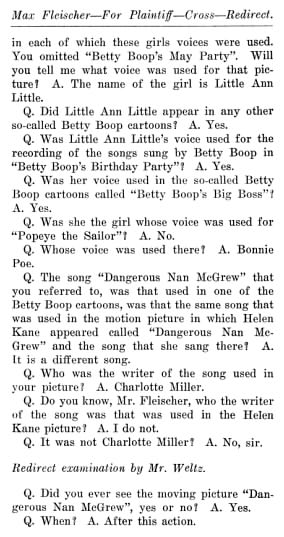











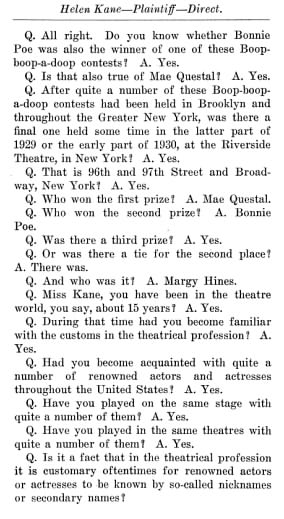



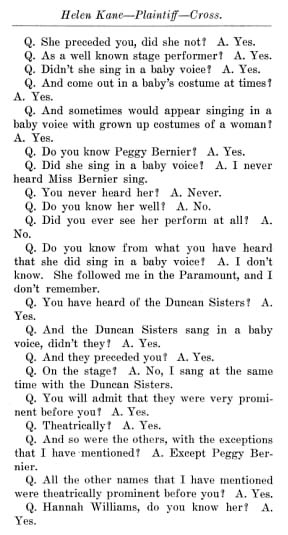














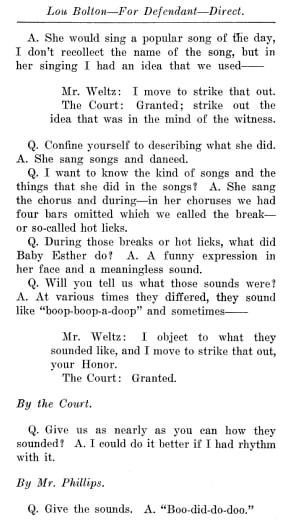




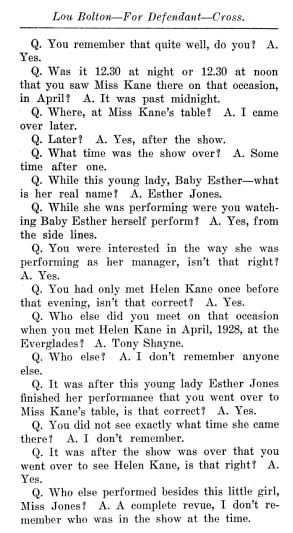






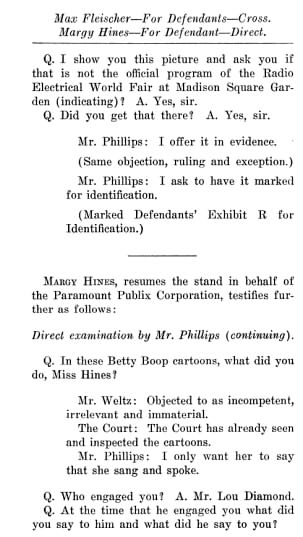












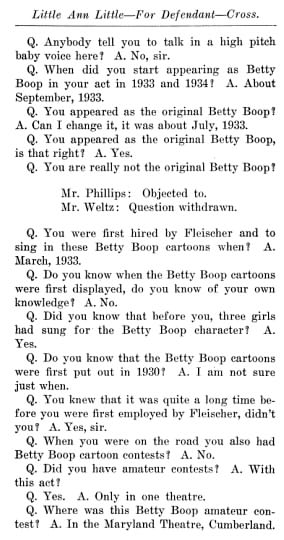
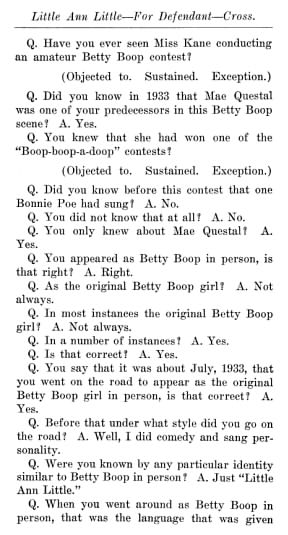











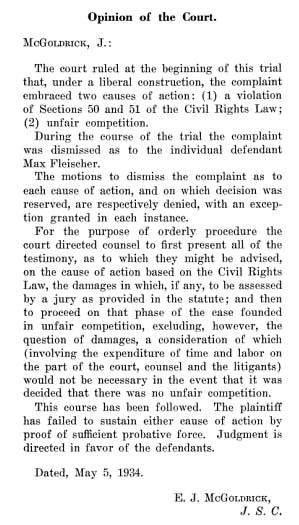
Samuel Robert Weltz & Outcome of the Lawsuit:

Helen Kane’s attorney Samuel Robert Weltz claimed that the footage of Baby Esther singing was “irrelevant, incompetent and immaterial” and stated that child star Baby Esther Jones was a Helen Kane impersonator. He was denied by the court. Jones was noted as performing a tribute to Kane in 1928, yet Jones had been scat-singing since 1925, and was also known for using this technique of singing. Jones was a Florence Mills impersonator. Mills was featured in the 1921 musical Shuffle Along, where the “Boop” gimmick is said to have been invented in an alternate form by Gertrude Saunders. It was a “Tweet-Tweet-Twat” for Saunders, and a “Tooty-Tooty-Too” for Mills.
Gertrude Saunders and Florence Mills inspired Blanche Calloway, sister of Cab Calloway to join the later adaptions of the musical Shuffle Along, after returning home in 1927, this inspired Cab Calloway. Cab was taught how to scat by the great Louis Armstrong.
Josephine Baker studied her rival Florence Mills and sciously sought to emulate her. In France “Baby Esther” known in America as Miniature Florence Mills in Paris later became a rival to Josephine, and was given the nickname Miniature Josephine Baker. Jones later met Baker at the Casino de Paris.
Kane didn’t scat until she made her stage debut in the 1928 musical Good Boy.
True research proves that Kane didn’t quite have the “Boop” routine. It was more of a “Poo” or “Poop” routine. And “But-Dut-De-Dut,” “But-Dut-Da-Dut” and others. This was eventually adapted to “Boop” by Kane, because people often misunderstood her when she said the words.
Helen Kane was described as utilising “Bumpee-Ump-Bump-Bump” as her final words in her “I Wanna Be Loved By You” performance in a Tuesday, November 6, 1928 review.
However in court, Kane claimed she did not know what scat-singing was.
But when asked how she had created this “Boop” technique, Helen Kane stated: “It’s a form of rhythm I created. There’s a bar in the music, and at the end there is a stop.” However interpolating “hot licks” into songs had already been established by other performers long before Helen Kane had started using the “scat-singing” technique that she claimed she had invented. Helen Kane made “Boop-Boop-a-Doop” famous but she was not the first “scatter” and she certainly did not “invent” the rhythm of interjecting “meaningless” sounds into songs.
According to vast research, Kane had already lost this case when she had admitted that singers such as the Duncan Sisters, Irene Franklin, Nan Halperin, Peggy Bernier, Hannah Williams had preceded her on the stage using a similar baby-doll style. In doing so, she admitted that her style was not original.
In many of Kane’s earlier newspaper interviews, she admits that “Vo-Do-Do-Deo,” “Vo-Dee-O-Dodo,” Vo-Do-Do-De-O,” and “Oh-Vo-De-Oh-Do” were inspirations to create her “Boop” routine and at one point was sometimes known as The Vo-Do-De-O Girl. These techniques of singing were inspired by Black singers at Harlem nightclubs.
Judge Edward J. McGoldrick saw the evidence and ruled in favor of Betty Boop. Helen Kane appealed her case for another injunction against Betty Boop.
It is possible that in 1928, Helen Kane and her partner Dan Healy who shared the musical sequence of “I Wanna Be Loved By You” in Good Boy went to the Cotton Club and drew inspiration for the scat-singing sequence from there. Healy was known to have worked with Cab Calloway at the Cotton Club years earlier. However witnesses “Lou Bolton” and “Miriam Luber” indicated that Baby Esther was “Booping” at the Everglades in early 1928, at that Helen Kane saw Jones’ performance from the audience with Jones’ then booking agent Tony Shayne.
Shayne had a very close business relationship with Kane, he also claimed that he had discovered her in some interviews. however the person that actually discovered Kane was Paul Ash.
Judge Carew the Appellate Division of the New York Supreme Court held no one could copyright a voice and told Kane that no one could copyright a voice and Miss Kane did not hold the copyright on the actions of the Fleischer character Betty Boop. This decision prohibited Helen Kane from further appeal.
Margie Hines in court, stated that it was her own “baby-voice” that she used to voice Betty not Helen Kane’s. Despite the fact that Hines was well-known for her “Helen Kane Impersonation,” and had won several contests years before the lawsuit, it appeared that Kane was suing for a voice she did not own.
Kane, according to Mae Questel, requested that Fleischer replace Questel with Kane. But he turned down Kane’s offer. Had Max Fleischer done this, Kane would have been able to sue.
Kane losing this lawsuit is like retaliation for Kane’s attempt to sabotage Questel’s career in 1930 by filing formal complaints against Questel for using the “Boop-Boop-Doop” title in her RKO act.
In 1934, the voices of Betty with Max Fleischer responded to Kane in song in a newsreel short titled Betty Wins By A Boop, there they told Kane that she “couldn’t” take Betty’s “Boop-Boop-Be-Doop” away.

Hoping to get back at the Fleischer Studios, Kane decided to use Betty Boop’s image to promote her tour. Kane also contacted King Features Syndicate to compete against Betty in comic form in a short-lived comic strip titled Helen Kane the Original Boop-Boop-a-Doop Girl. The Brooklyn newspaper in New York suggested that Max Fleischer should sue Helen Kane for using Betty Boop’s image without permission, but Fleischer did not respond. After the lawsuit, Max had nothing nice to say about Kane, and in his honor a Brooklyn newspaper that Mr. Fleischer often read blacklisted her from their newspaper in favor of Mr. Fleischer.
Helen Kane’s comic strip didn’t last very long and was later replaced by a brand new Betty Boop comic series.
Below Are Some of Samuel Weltz Arguments:

Samuel R. Weltz compiled evidence for the court demonstrating how Betty Boop was a caricature of Helen Kane.
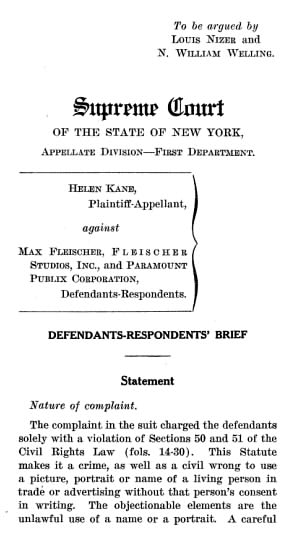
And how Bonnie Poe, Margie Hines and Mae Questel three of the girls who voiced Betty Boop got their start impersonating Kane in contests held by Kane. It’s very long and pointless, because as Kane lost the case. She didn’t win this lawsuit, she lost. Proving her to be not so original.
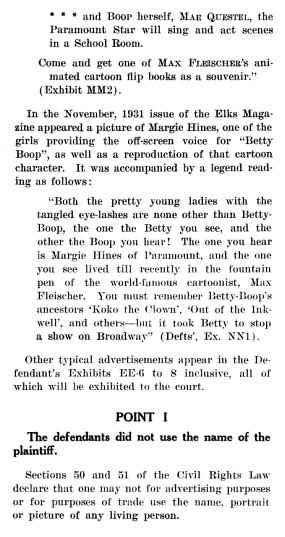
Kane’s demise also came about when she “allowed” impersonation and was actively “seeking” a double throughout the 1920s and 1930s. She got a double in cartoon form, but couldn’t handle the competition.
Betty Boop did originally start off as a sort of dog-like caricature of Kane. But by 1931, the Betty Boop character was developed greatly. Betty wasn’t just inspired by Kane alone, she was also inspired by Clara Bow the “It” Girl, and also many other girls, the Fleischers of the 1930s have also cited stars such as Mae West and Greta Garbo.
Also the women who voiced Betty, such as Little Ann Little, Margie Hines, Bonnie Poe and Mae Questel served as model and voice. Sometimes they modeled as Betty Boop while the cartoonists rotoscoped them.

When Betty made her debut, she gave off more Mae Questel than anything. Questel is said to have deeply inspired the creation and evolution of Boop. After all, in Betty’s initial appearances, especially her appearance in Stopping the Show, she was that of an “impersonator” and “mimic” something that Questel was in real life.
As the years passed many of the women who voiced Betty faded into obscurity. Kane made a short-lived comeback, but she too faded. The only person left was Mae Questel.
It is noted that in many later appearances and interviews, Questel rarely mentions Helen Kane. In a 1983 interview, when hinted that someone else was the model, Questel gets slightly offended and says that she herself was the model for Betty Boop. The only valid reference that Questel imitated Kane was in the 1983 film Zelig.
In that film Questel provided the singing for the song “Chameleon Days” but Helen Kane’s name is on the record. This is because Kane was the baby-talk star of that era, not Questel. Questel did dethrone Kane at one point, but she was not the star of that era, she was a mimic.
It was Sugar Kane who was the star, however she couldn’t take competition. Competition that she actually requested, it was Kane who asked girls and women to imitate her and that is how Betty Boop was born. Without Kane, there would probably be no Betty Boop today.
However like all stars, fame tends to fizzle out.
Regardless of the “$250,000 Infringement Lawsuit,” the animated cartoon character “Betty Boop” keeps the spirit of these “Boopers” alive.
